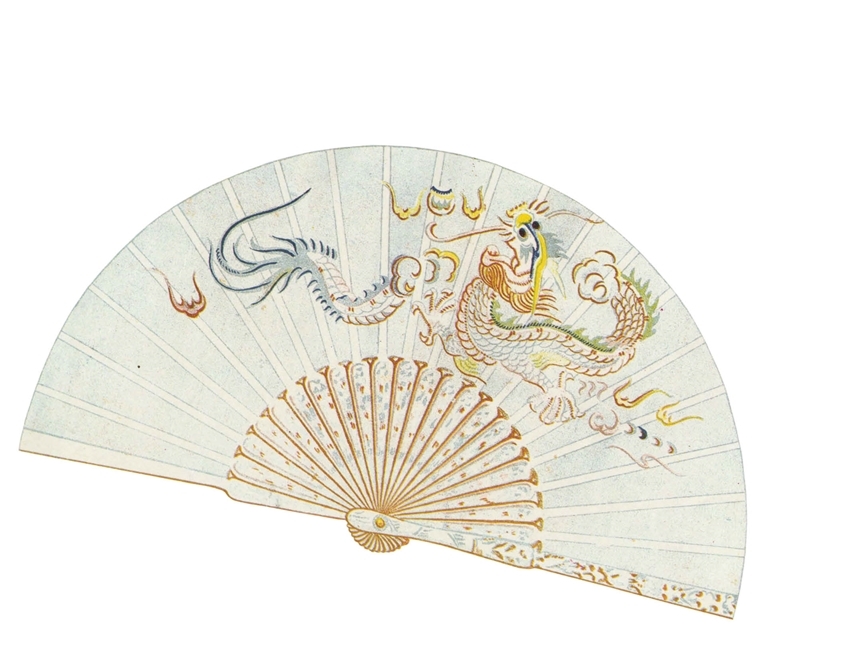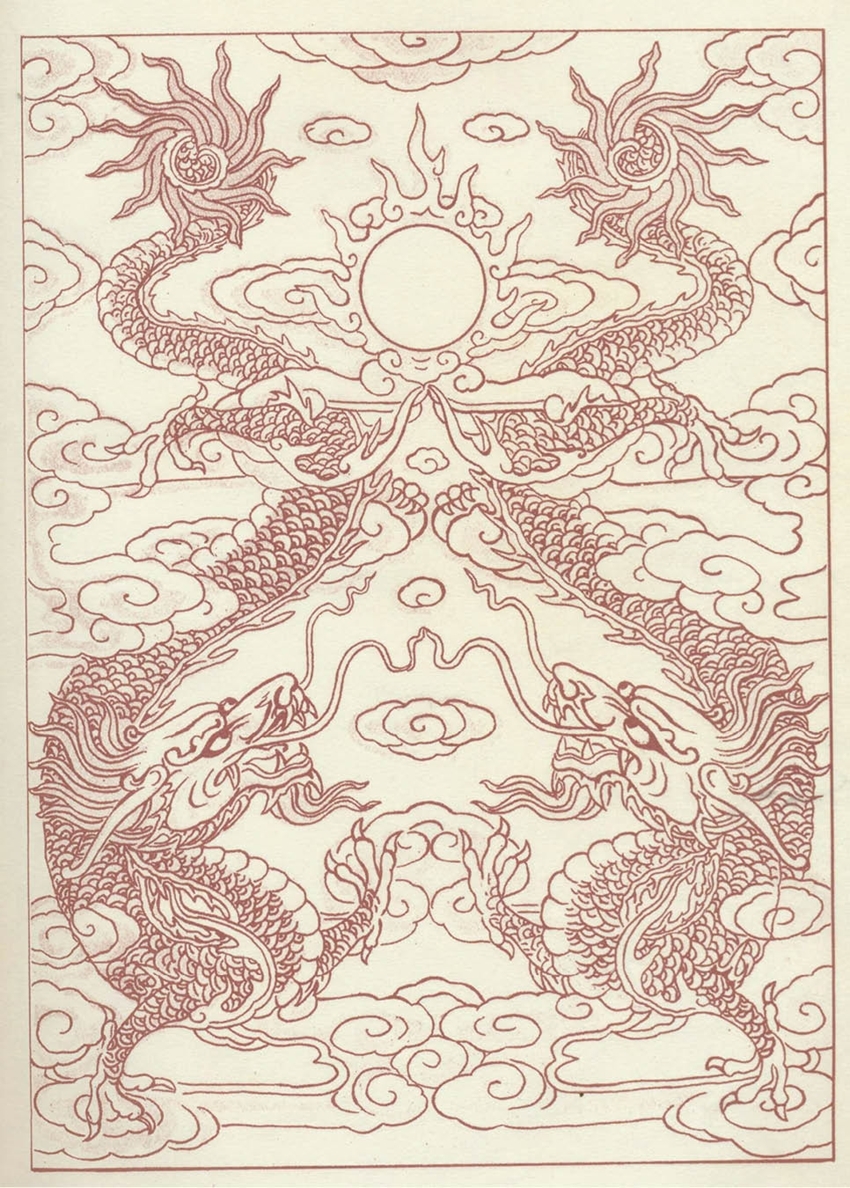 |
| Two dragons flanking the moon. Photo: L. Cadière |
Capital is where "the Dragon rolls and Tiger sits", so the Green Dragon and White Tiger are modeled according to the feng-shui theory. That dominant spirit pervades Hue's life, from the legitimacy of the dynasty, the emperor, and the royal family in the royal palace to the magical "transformation" method throughout society. Thanks to that, the creation of a vast Dragon world with many layers, levels, and nuances of expression, from the aspects of transformative Dragon and the Dragon transformation, was researched by L. Cadière in 1919 through the L'Art à Hue.
The Dragon has a prominent position in traditional Vietnamese decorative arts. The royal palace is the home of the dragon because the identification with the true destiny of the son of heaven/golden Dragon is the sole privilege of the emperor at the highest level. This Dragon has 5 claws and appears in all shapes and sizes, from a majestical presence to sudden appearance and disappearance everywhere full of philosophy, with the famous Nine Dragons Hiding in the Cloud or Nine Dragons in the Clouds...
The Dragon appears everywhere, from temples to private houses, roof edges, facades, house beams, furniture or fabrics, dishes, and even in bonsai art. It comes in its transformative stage, hiding all its claws or looming and gradually reducing its four claws according to the appropriate codes, subjects, and spaces.
From the sacred life of unbeatable power, the dragon appears everywhere, even shaping the system of Vietnamese sea deities: Dong/Nam Hai Long Vuong (East/South Sea Dragon King), with Thuy Long Thanh Phi (Water Dragon Holy Lady), and five princes guarding the five directions, from the First to the Fifth Dragon King. That supernatural origin is an unlimited material for Hue artisans to express Dragon forms, from simple to complex forms, suddenly hidden and appearing in a "transformation" method full of improvisation to harmonize and suit the context.
From the Chinese dragon image standing out with deer horns that function as ears, a camel head, demon eyes, a snake neck, a crocodile belly, fish scales, eagle claws, and cow ears (P. Corentin Petillon, 1909-1910, Allusions littéraires, p. 464)..., Vietnamese artists have shown that dragons have many differences, although they still have horns, fiery eyes, fish scales covering the dragon's body, a part shaped like a mane with a crest, sharp claws, and a twisted tail.
 |
| A dragon decorated on a fan. Photo: L. Cadière |
Complying with conventions and artistic senses and depending on aesthetic tastes, dragons appear clearly or indistinctly everywhere in Hue's works of art. First, from a sloping view, dragons appear, wind and stretch across rooflines, on stair handrails, embroidery patterns, carved or painted screens... Looking directly, the dragon nests impressively, often found on the facade of the main gate. Sometimes, you can only see the dragon's head with its front legs curved towards its face, located in the triangular frames of the facade of pagodas and temples, together with the bat shape on the forehead of the stele or the kneeling legs. A dragon holding the word “Thọ” (Longevity) in its mouth is a good omen with a desire for longevity.
On the rooftop edges, dragons appear symmetrically at both ends of the roof. A fireball is located in the middle – “lưỡng long triều nguyệt” (the two dragons attend the moon). This motif also appears in many architectural works, furniture, and fine arts... as a succinct symbol of the desire for peace, similar to the “lưỡng long tranh châu” (two dragons fight over the fireball). In the suitable space, the dragon is surrounded by clouds in the sky or waves in the river, hidden in the way of lying dragons and dragons hiding in clouds. In the water, the dragon is associated with the carp in the image of “ngư long hý thuỷ” (the fish and the dragon play with water).
From dragons, folk philosophy and the talent of artisans have created many initial levels of dragons: the Giao and the Cù. The Giao, according to the Dictionnaire classique de la langue chinoise, suivant l'ordre de la prononciation (P.Couvreur, 1911) is a "hornless dragon, shaped like a snake with a slender neck, four legs and white crest under the throat”, or “a folding dragon with four legs” (Eitel), “a dragon with a scaly body” (Giles), and a type of “crocodile or caïman” (Génibrel).
Meanwhile, the Cù is a type of “horned dragon, many people think it is a hornless dragon” or “horned baby dragon”, “dragon, a legendary beast, many say “horned” animal or “a form of hornless dragon. People often believe that this type of dragon usually lives underground, and rivers are where it appears.” The legend of the Cù in Hoi An Bridge Pagoda is a case.
Vietnamese artisans often express the Giao and Cù without horns, manes, crests, and many unclear details because they are always “transforming”. Only the head and neck are visible. All of this seems consistent with folk life because commoners do not dare to represent dragons according to the code. So, in many cases, the shown images, and artists and owners are easily prone to ambiguity, making it difficult to separate the motifs of dragons and other forms of Giao, Cù, and even quite popular scaled dragons.
The method of transformative dragon and dragon transformation has dramatically enriched the dragon motif system, appearing in many dragon culture decorations along with flower leaves, vines of flowers and leaves, bamboo, pine, peony, and chrysanthemum... In a more vivid, delicate, and meaningful expression, the fingered citron (Buddha’s hand) and lotus flower sometimes turn into a dragon's head when viewed from the front.
Dragons carry many ideological, cultural, and artistic values, especially in the cultural center of Hue during its transition from the Capital to the Ancient Capital. It expresses the consistent desire for peace and harmony ideology throughout, which is even more meaningful in the current context of climate change and strong urbanization. Especially the unique and distinctive visual art heritage and diverse variations of the Dragon are valuable materials to help preserve and promote the value of traditional cultural heritage in the research and restoration of monuments, restoring antiques, and developing handicrafts - typical strengths of the heritage city of Hue.
